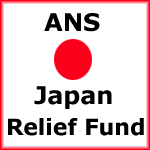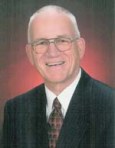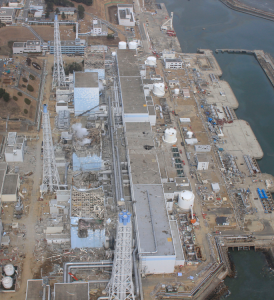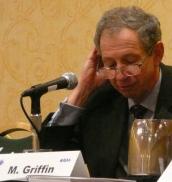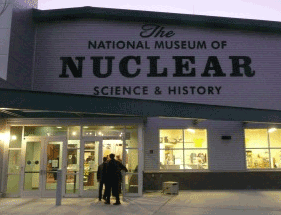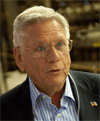It has all the challenges of Three Mile Island plus there are four damaged reactors not just one
By Dan Yurman
The effort to contain the nuclear reactor crisis at Fukushima brings to mind the 1933 horror movie King Kong, in which a giant ape, escaped from captivity, and perched at the top of the Empire State Building, is fatally wounded by a swarm of war planes of the era.

King Kong - image source Wikipedia
While fictional film character Carl Denham intones his famous last line “It was beauty killed the beast,” a less prosaic New York sanitation department might have been wondering how to remove a giant dead gorilla carcass from the corner of 5th Ave. and 34th St.
Kong’s fall would have created a cleanup problem of immense scale. It would have been “beyond the design basis” of even the entire fleet of city garbage trucks.
Six gorillas at Fukushima
This dramatic movie metaphor is relevant as a visual image of the scope of the problem faced by Tokyo Electric Power Corp. (TEPCO) with the eventual decommissioning of six reactors at Fukushima. The utility doesn’t have just one dead giant gorilla, there are six. The first three nuclear reactors are likely to be found to be fatally compromised with heat damaged fuel assemblies from loss of cooling water. Partial melting of fuel may be part of the problem.
Massive hydrogen explosions blew the roofs off of secondary containment structures at reactors 1, 3, and 4. The fourth reactor is also likely severely damaged beyond repair. Its spent fuel pool is exposed to the open air as a result of one of the huge hydrogen explosions.
The fifth and sixth reactors, relatively undamaged, may never restart because of wrecked balance of plant infrastructure and ferocious public opposition which is leveraged by Japanese law that gives veto power over nuclear facilities to the provincial government.
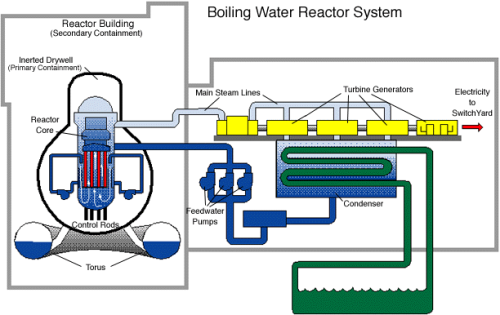
BWR reactor schematic. Image from World Nuclear Association
The 15-meter high tsunami swept away the normal infrastructure of a nuclear power station which, along with rubble from the hydrogen explosions, put debris across access roads and rail sidings blocking delivery of emergency equipment. Efforts to control leaks from buildings and trenches may go on for months or years. In short, it will be a very dangerous place to conduct cleanup work.
Precedent from Three Mile Island
The precedent TEPCO will have to rely on is the cleanup of the Three Mile Island (TMI) accident in the U.S. The cleanup of the badly damaged reactor at Three Mile Island, which began in 1979, took more than a decade ending in 1993. TEPCO’s timeline may be much longer.
The New York Times reported that the first major phase of the TMI cleanup was completed in April 1990, when workers finished shipping 150 tons of radioactive wreckage from the damaged reactor vessel to Idaho for storage. According to a history of the Idaho lab’s involvement in the project, 49 casks containing reactor fuel debris were transported by rail through 10 states in 22 shipments. Cleanup at that point had cost over $1 billion.

TMI cask on US Hwy 20 near INL. Image courtesy Idaho National Laboratory
There are significant differences between the situation at TMI and Fukushima. The biggest and most dangerous differences are the extent of uncontrolled radioactive contamination outside the reactors at the plant site.
A second cleanup challenge, unlike the TMI experience, is that the surrounding countryside in Japan is like a war zone with lack of access by road and rail, power lines are down, and potable water, food, and housing are all in very short supply.
There some immediate steps TEPCO needs to take to start the cleanup process at Fukushima. It must get most of the radioactive water off the site and control what remains. It needs to control radioactive debris from the hydrogen explosions. Most importantly, it must find a path to remove the fuel from the damaged reactors or execute a plan to store it in place indefinitely.
Drying out the Fukushima reactor site
The removal of huge volumes of radioactive water from the site is the first priority. The Japanese have been pouring uncounted tons/day of water on four reactors since mid-March. Headlines in the news media on April 5 report TEPCO needs to remove 11,500 metric tonnes of water from the plant.
The Wall Street Journal reported April 5 that TEPCO was discharging 4,800 (short) tons/day of radioactive water directly into the ocean. That would be 96,000pounds or about 11,500 gallons of water. TEPCO characterized the radioactivity level of the discharge as “low.”

Fukushima reactor complex prior to March 11, 2011
According to the WSJ, authorities said about 20,000 tons of radioactive seawater still remain in the turbine building and the cable trench of each of reactors Nos. 1-3, for a total of 60,000 tons. That’s 120 million pounds of water or 14,370,000 gallons of water. (1 gallon of water weighs 8.35 pounds)
Readers should be aware that the western press has had numerous difficulties with translations of Japanese language reports of reactor status information. Mistakes and errors by TEPCO, as well as wholesale retractions, have created problems for almost all numerical references from the utility subjecting them to continuous second guessing and review.
Anyway you count it, there is a lot of water and no way to store or dispose of it on the site. The option exists for TEPCO is to run a pipeline several miles out to sea from the reactor site and pump the water out there.
According to a BBC report for April 4, 2011, the Kuroshio Current is the North Pacific equivalent of the Gulf Stream in the Atlantic. It hugs the Asian continental slope until about 35 degrees North, where it is deflected due east into the deep ocean as the Kuroshio Extension.
Experts interviewed by the BBC say this means pollutants in its grasp, such as radioactive water from Fukushima, will tend over time to be driven out into the middle of the Pacific where they will become well mixed and diluted over time.
There will likely be heated political objections to this scenario, but TEPCO is more or less out of land-based options. It needs to get the radioactive water out of the plant if it has any chance to make progress with gaining control of even more dangerous radioactive contamination throughout the entire reactor complex including spent fuel in Unit 4 and damaged fuel in Units 1-3.
Securing the site
Next, the site needs to be washed down to remove surface radioactive contamination. Yes, this will produce more radioactive water, but it’s better to send it out to sea than to leave it in place to harm site workers.
Also, according to an April 6 New York Times report, radioactive particles from the spent fuel pool for unit 4 may have been blown as much as a mile away by the hydrogen explosion. These materials need to be found and removed to a safe interim disposal area.

Fukushima reactor complex after hydrogen explosions at reactors 1, 2 & 4
Fukushima reactor units 1-4 could to be covered by an semi-rigid, inflatable tent the size of a football stadium. This structure, supported by a light steel framework and constant air pressure blown into it, would protect the damaged reactors and cleanup workers from the elements. While a typhoon or other extreme weather could damage the air supported structure, it is easier, quicker, and less costly, to rebuild one than to try to encase all four reactors in a giant concrete shell.
None of this site preparation work can take place until the reactors themselves are in a state of cold shutdown. This may be accomplished through restoration of electrical power and control of the reactor cooling systems. If the cooling systems are damaged, and don’t work, TEPCO will have to come up with a system that does the job which will likely continue producing hundreds of tons a day of radioactive wastewater.
It could be some time, perhaps as long as several years, before remote controlled, radiation hardened robots can be sent into the reactor cores at Units 1-3 to take a look at damage there. The reason is the wreckage of the damaged secondary containment structures at reactor units 1 & 2 will have to be removed so a work crew and their gear can be staged to access the primary containment structure. Unit 3, which has a relatively intact secondary containment structure, could be the first reactor to give up its secrets.
According to a Wall Street Journal interview April 2 with veterans of the cleanup at TMI, heat damaged fuel elements will be difficult to extract from the reactor pressure vessels especially if temperatures were high enough to melt the zirconium cladding that hold the fuel elements in place. Once that happens, fuel pellets fall to the floor of the reactor pressure vessel.
If the any of the fuel itself is melted, TEPCO might opt to wait for years with a buttoned up reactor pressure vessel and secure primary containment structure for everything to cool down through natural attenuation of residual heat and the cycle of radioactive half lives. Eventually, like TMI, the fuel from the reactors and spent fuel pools could be transferred to permanent dry cask storage.
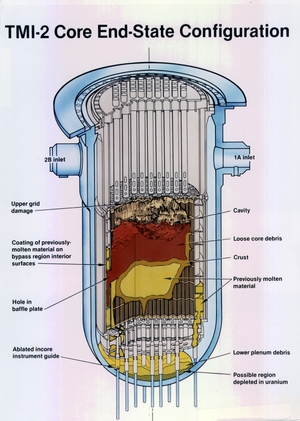
TMI fuel metl down - Image courtesy Idaho National Laboratory
If TEPCO can’t find safe technical path forward to this solution, then an alternative is to eventually entomb the reactor pressure vessels in place by pouring concrete into the primary containment structures for units 1-3, and the spent fuel pool in unit 4. This solution may be forced on TEPCO if it finds that any of the primary containment structures are damaged from the original earthquake or by aftershocks.
According to a Bloomberg news report for March 30, the government hasn’t ruled out sealing the plants 1-4 in concrete says Chief Cabinet Secretary Yukio Edano. Though he didn’t mention it, one of the issues the government will need to evaluate is whether the primary containment structures could safely hold all that concrete. That weight could put new stressed on the structures.
Cost of cleanup
TEPCO’s long-term cleanup costs could be in the tens of billions and take decades to complete. This activity alone could turn the utility into a semi-permanent ward of the state unless cleanup, and liabilities, are taken over entirely by the government through some form of receivership for the reactor site.
Fukushima could remain a no man’s land for decades given the huge, almost unimaginable costs of cleanup. The government will likely look to find reasons to stretch out cleanup for financial reasons regardless of domestic and international pressure. Japan’s government is carrying a huge debt load as it is.
The complexity of performing the decommissioning of six reactors four of which are severely damaged and in an unknown condition will drive up costs at every turn. The last time Japan decommissioned a reactor, which was a clean site, it took the government more than two decades to complete the job.
By comparison, the decommission of the Zion nuclear power plant in Illinois, which is well controlled under regulatory scrutiny from the NRC, is expected to cost $900 million and take a decade to complete. A New York Times report for November 22, 2010, noted it cost Exelon $10 million a year just to “baby sit” the plant in cold shutdown status.

Zion nuclear power station in Illinois awaiting decommissioning
The plant will be chopped up into pieces and shipped to a special landfill in Utah that can receive solid radioactive waste. There will be no separation of radioactive and non-radioactive materials. Everything will be assumed to be radioactive and will go to one disposal site.
Where to put radioactive waste?
This raises a key question for Japan. Where will it dispose of radioactive debris from Fukushima? It can’t leave the material at the seashore to perpetually contaminate the cities and farms in the surrounding countryside and pollute highly productive fishing waters.
The Kyodo News wire service reported April 5 that the Japanese government is studying the possibility of borrowing a Japan-funded radioactive waste disposal facility from Russia to help contain radioactive water.
“We are checking whether it is technically possible to use the facility for this current event, and whether the facility’s machines are working smoothly,” Hidehiko Nishiyama, a spokesman for the government’s Nuclear and Industrial Safety Agency, told a press conference.

Suzuran - At this time, it is moored opposite Vladivostok's shores at the Zvezda Shipyard in Bolshoy Kamen Bay.
He also said Japan has been communicating with Russia about using a floating facility, called Suzuran, (right) which Japan gave to Russia in 2001 to help dispose of low-level radioactive liquid waste from decommissioned nuclear-powered submarines.
Japan gave the facility to Russia as environmental concerns were raised after Russia dumped radioactive waste into the Sea of Japan in 1993 in the process of dismantling its nuclear subs.
There is even less certainty for high level waste and other solid radioactive debris (RH-TRU) which cannot be contact handled in the near term. Ten years ago, Japan created the Nuclear Waste Management Organization of Japan (NUMO) which was established under the jurisdiction of the Ministry of Economy, Trade and Industry.
NUMO is responsible for selecting a permanent deep geologic repository site, construction, operation and closure of the facility for waste emplacement by 2040. Site selection was begun in 2002.
Final selection of a repository location is expected by 2027. Japan may have to speed up the site selection process once it gets serious about the decommissioning of the six reactors at Fukushima. A 2008 briefing shows a lot of process work but not much progress in selecting much less building a geologic repository for high level waste. There’s a long way to go.
_______________________________
Dan Yurman publishes Idaho Samizdat, a blog about nuclear energy. He is a frequent contributor to the ANS Nuclear Café.
